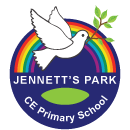Download the Geography - Intent, Implementation, Impact document
Intent
At Jennett’s Park Primary School our Geography curriculum is designed to develop children’s curiosity and fascination about the world and its people that will remain with them for the rest of their lives. Our aims are to fulfil the requirements of the National Curriculum for Geography; providing a broad, balanced and differentiated curriculum; ensuring the progressive development of geographical concepts, knowledge and skills; and for the children to develop a love for geography. Teaching should equip pupils with knowledge about diverse places, people, resources and natural and human environments, together with a deep understanding of the Earth’s key physical and human processes. (The 2014 Primary National Curriculum in England) Through high quality teaching, we develop the following essential characteristics of geographers:
- An excellent knowledge of where places are and what they are like, both in Britain and the wider world;
- A comprehensive understanding of the ways in which places are interdependent and interconnected;
- An extensive base of geographical knowledge and vocabulary;
- Fluency in complex, geographical enquiry and the ability to apply questioning skills, as well as effective presentation techniques;
- The ability to reach clear conclusions and explain their findings;
- Excellent fieldwork skills as well as other geographical aptitudes and techniques;
- The ability to express well-balanced opinions, rooted in very good knowledge and understanding about current issues in society and the environment;
- The ability to begin to implement change in our local area that could lead to worldwide change in current issues in the environment e.g. plastic pollution
- A genuine interest in the subject and a real sense of curiosity about the world and the people who live here.
- An interest and curiosity for learning outdoors
Implementation
We have created a comprehensive progression document for staff to follow to best embed and cover every element of the computing curriculum. The knowledge/skills statements build year on year to deepen and challenge our learners.
| Locational knowledge | Place knowledge | Human and Physical Geography | Fieldwork skills |
| Name, locate and identify places around the world including regions, characteristics, cities, topographical features, latitude, longitude, equator. | Understand geographical similarities and differences through the study of human and physical geography of a region
Compare one region to another across the world |
Geographical vocabulary
Physical geography, including: climate zones, biomes and vegetation belts, rivers, mountains, volcanoes and earthquakes, and the water cycle Human geography, including: types of settlement and land use, economic activity including trade links, and the distribution of natural resources including energy, food, minerals and water |
Use maps, atlases, globes, digital mapping etc. to locate countries and regions.
Use fieldwork to observe, measure, record and present the human and physical features in the local area using a range of methods, including sketch maps, plans and graphs, and digital technologies. |
How to Implement the progression document and long term plan
Geography is taught in topic centred lessons across the school so that Geography will be taught explicitly on some occasions, and through cross curricular links on others. Each topic has a main subject focus but has many cross curricular links. One topic will always be more Geography focussed in the year.
For example: If my class were covering The Great Fire of London in Year 2, I could set the children the task of learning more about London. First, they would need to locate London on a UK map “name, locate and identify characteristics of the four countries and capital cities of the United Kingdom”. They then may begin researching about London and what it is like now using maps, atlases, photos, internet etc. This will also create cross curricular links for History and Computing. “use aerial photographs and plan perspectives to recognise landmarks and basic human and physical features; devise a simple map; and use and construct basic symbols in a key” This topic would be more centred around History but has many Geographical elements to it which can be explored. The could then compare London in the past and the present as well as comparing London to another region such as their own local area or a region in a non- European country. “understand geographical similarities and differences through studying the human and physical geography of a small area of the United Kingdom, and of a small area in a contrasting non-European country”.
Impact
We encourage our children to enjoy and value the curriculum we deliver. We will constantly ask the WHY behind their learning and not just the HOW. We want learners to discuss, reflect and appreciate the impact geography has on not just themselves but on the world around them. We encourage children to take responsibility for the world around them and regularly discuss and reflect on the impact we can have on our world. We learn about different cultures, places, traditions, people, countries and identify and celebrate their similarities and their differences. We encourage regular discussions between staff and pupils to best embed and understand this. The way pupils showcase, share, celebrate and publish their work will best show the impact of our curriculum. We want children to be well rounded confident, caring and understanding citizens of our world who take responsibility for their actions and understand that they can have a positive impact on our world. This will be best shown through discussions, written work and presentations but most importantly through the personal ethos of each individual child and how they demonstrate this on a daily basis.
Download our medium term planning for Geography across each year group.
